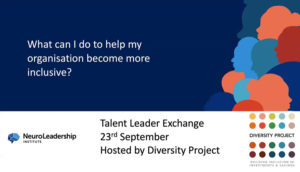If we are to understand the world around us, to make reliable financial decisions for our clients and to do so in the context of the societies and economies within which we operate, we need to bring to the task a diversity of mindset and approach.
The Diversity Project is seeking to bring together work which has encouraged such diversity effectively, to draw attention to current projects and to develop new ideas.
Our approach is collaborative: there is excellent work going on already and we want to bring that to as wide an audience as possible. We want to share ideas, effective programmes and plans, so that we do as good a job as we can. There is a considerable commitment to doing that and the purpose of this blog is to help share some evidence.
My interest in the Diversity Project was sparked by conversations with others working within the industry. I heard reported instances where the number of female applications to graduate programmes was below 20% (although some firms see considerably higher rates). Colleagues on the project noted instances where systems of work experience and internships appeared to run the risk of deterring those who didn’t have contacts, didn’t know how early to plan such activity, or couldn’t afford the programmes (although many now do pay).
“I heard reported instances where the number of female applications to graduate programmes was below 20%”
Clearly we need to make sure the pool of people coming into our sector is as deep and wide as possible. Without raising awareness of prospective careers within the industry amongst a broader group, we simply won’t have the talent applying to it in the first place.
I offered to write a reasonably regular review of what I have seen in the academic world, which might add to our discussions. I should say that I am not an academic, and I cannot promise a rigorous academic approach: this is a personal blog rather than some sort of literature survey.
On the other hand, it may be a bit nerdy. Please do let me know if you see anything which you think might contribute to this blog: I hope to make this a collaborative endeavour. We do need to share experiences and information to make a difference. I am also grateful to my daughter, Helena Bates, for searching through academic literature and directing me to some very interesting papers.
To start with: in this context, language does matter. Certain words may automatically may make our world less appealing to some groups, and yet these words appear in many of the job descriptions attached to roles within the industry, and therefore result in the potential ‘drop-off’ of applications almost immediately upon reading.
“Certain words may automatically may make our world less appealing to some groups”
The research back up for this is quite direct. In 2011, two academics from the University of Waterloo, in Canada, and one from Duke University in the US (Gauchier, Friesen and Kay) published research on the way gender stereotypical wording in job adverts tends to support gender inequality.
Their context was as social psychologists looking for evidence that institutions with a particular bias (in this case gender) would find ways of reinforcing that bias, as predicted by social dominance theory.
In order to look for evidence of how male biased institutions might have developed such mechanisms and to understand how those mechanisms might work, they surveyed the responses of a group of 102 Canadian students to a series of created job adverts for a variety of industries, from plumbing to nursing to engineering.
Having developed a coding system for the words used, and developed a list of male-stereotype words (such as challenging, determined, ambitious, analytical) and female-stereotype words (considerate, cooperative, honest, sensitive), they developed male and female language “heavy” adverts for three separate firms (one typically male dominated, one female dominated and one generally thought of as neutral).
They then looked at the way that male and female students rated the appeal of jobs containing more male-stereotype words and those with more female-stereotype words.
When adverts were constructed with more male words , female students found the opportunity less appealing, compared with those adverts containing more female-stereotypic words. Both groups assumed there would be more men in the firms represented by male stereotypic language, and women considered they would belong less. There was not a mirror image preference exhibited by male students against jobs with more female-stereotypic language.
Now this is a small sample. The language stereotypes developed might make you feel a bit queasy. However, this evidence does suggest that it’s worth thinking about quite how a job advertisement comes over, and whether any particular group is going to feel that the opportunity isn’t for them (the paper suggests that some phrases may also unwittingly exclude those from less advantaged socio-economic groups).
Some organisations have taken this work into account, it seems: one graduate programme description for a major investment management firm talks about collaboration, inclusion, excellence and working for clients.
It’s really important to consider what happens to CVs.
There was a startling paper by Professor Marianne Bertrand of the Chicago University Business School and Professor Sendhil Mullainathan, from the Department of Economics at MIT. It’s called ”Are Emily and Greg More Employable Than Lakisha and Jamal? A Field Experiment on Labor Market Discrimination”.
This is quite an old paper, but gives a very clear picture of what happens to CVs in the Boston and Chicago areas. It also refers to previous studies in the UK.
Briefly, the research team created some 5000 CVs, high skilled and low skilled, and gave half of them very identifiable African American names and half of them very identifiable white American names.
These were sent to 1300 job adverts. On average, the applicants with white names needed to send 10 CVs before they were called back for interview, whereas the applicants with African American names needed to send 15 – a 50% increase. Another way of looking at it is that a white name was equivalent to about 8 years’ extra experience. The gap for call backs widened with the quality of the CV.
“On average, the applicants with white names needed to send 10 CVs before they were called back for interview, whereas the applicants with African American names needed to send 15”
The BBC reported on this issue last year, and the UK government suggested that UCAS should stop using names from 2017 and a number of large organisations such as HMRC, Teach First, the Civil Service and KPMG are discussing names-blind CV assessment.
Do let me know if you have already found ways of dealing with these difficulties, whether you have found other useful research we should share, or other ways of widening the scope of your recruitment processes.





